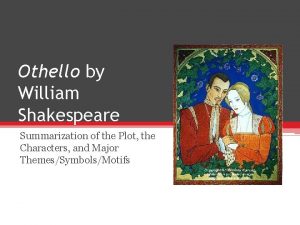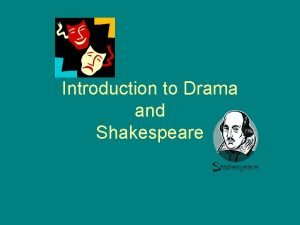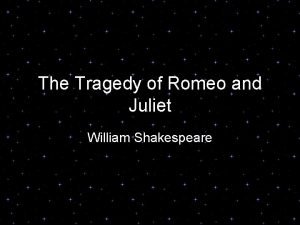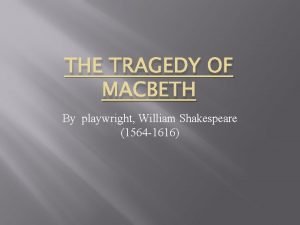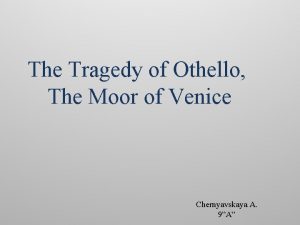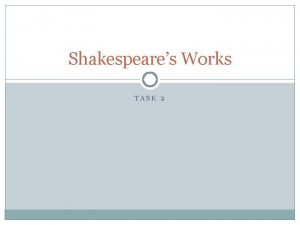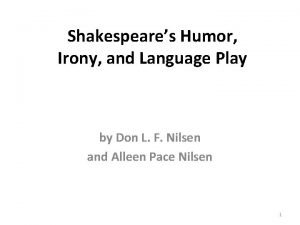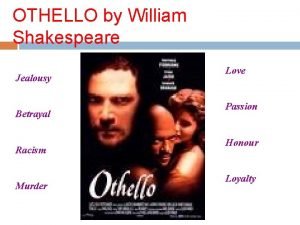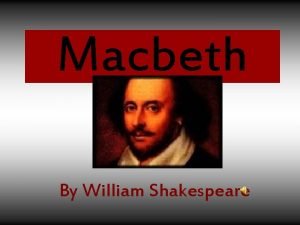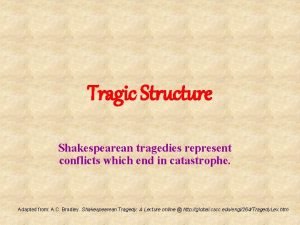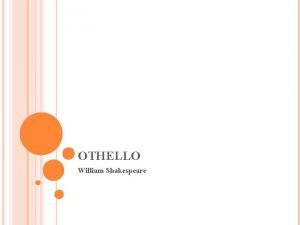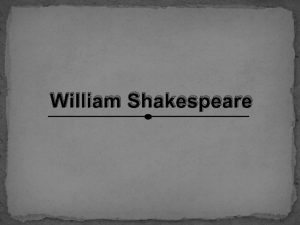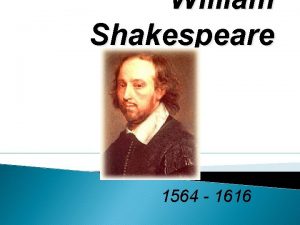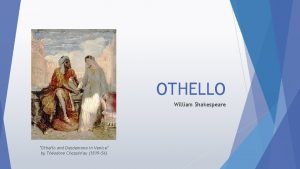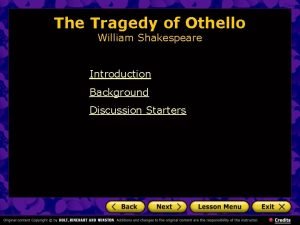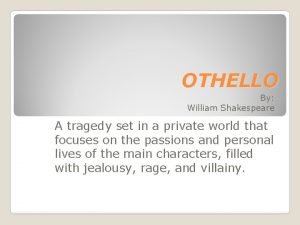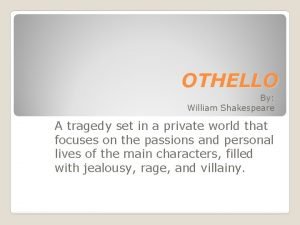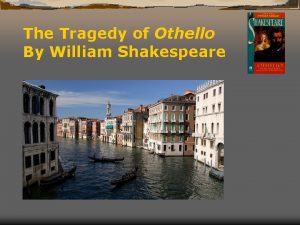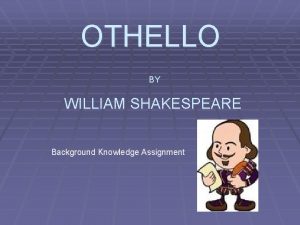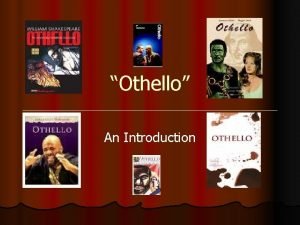OTHELLO William Shakespeare TRAGEDY A play in which
















- Slides: 16

OTHELLO William Shakespeare

TRAGEDY A play in which the main character (tragic hero) suffers a downfall as a result of a fatal character flaw, errors in judgment, or forces beyond human control (such as fate) A Shakespearean tragedy usually contains the following elements: A central character of high rank has a tragic flaw, or weakness A chain of events, partly caused by the flaw, leads this character to disaster Lively action creates a vivid spectacle, or public display of events Comic scenes provide relief from the mood of sadness

TRAGIC HERO A person of high rank who, out of hubris (an exaggerated sense of power and pride), violates a human, natural, or divine law By breaking the law, the hero poses a threat to society and causes the suffering or death of family members, friends, and associates In the last act of a traditional tragedy, these wrongs are set right when the tragic hero is punished or dies and order is restored

ELIZABETHAN DRAMA Blossomed in the late 1500 s, during the reign of Queen Elizabeth I Elements: Playwrights turned away from religious subjects They began writing more complex plays about nonreligious subjects They used ancient Greek and Roman plays, including tragedies, as models

SHAKESPEARE’S LANGUAGE Since Shakespeare’s plays are poetic dramas, he often shifts from average word arrangements to the strikingly unusual so that the line will conform to the desired poetic rhythm Often, too, Shakespeare employs unusual word order to afford a character his own specific style of speaking

SHAKESPEARE’S LANGUAGE Shakespeare’s most frequently used types of wordplay are common: metaphors, similes, synecdoche and metonymy, personification, allusion, and puns

SHAKESPEARE’S LANGUAGE – METAPHOR/SIMILE Metaphor: a comparison in which an object or idea is replaced by another object or idea with common attributes Similes: compare objects or ideas while using the words “like” or “as”

SHAKESPEARE’S LANGUAGE METONYMY Metonymy: a figure of speech using the name of one thing for that of another which it is associated Example: using crown to mean the king (as used in the sentence “These lands belong to the crown”). Since a crown is associated with or an attribute of the king, the word crown has become a metonymy for the king.

SHAKESPEARE’S LANGUAGE SYNECDOCHE Synecdoche: a figure of speech using a part for the whole Example: using the word boards to imply a stage. Boards are only a small part of the materials that make up a stage, however, the term boards has become a colloquial synonym for stage

SHAKESPEARE’S LANGUAGE It is important to understand that every metonymy is a synecdoche, but not every synecdoche is a metonymy This is rule is true because a metonymy must not only be a part of the root word, making a synecdoche, but also be a unique attribute of or associated with the root word

SHAKESPEARE’S LANGUAGE Personification: human capacities and behaviors are attributed to inanimate objects Allusion: a reference to another author or to a historical figure or event Puns: work through the ambiguity that results when multiple senses of a word are evoked; homophones often cause this sort of ambiguity

SHAKESPEARE’S LANGUAGE Some lines are actually rhymed verse while others are in verse without rhyme; and much of Shakespeare’s drama is in prose Shakespeare usually has his lovers speak in the language of love poetry which uses rhymed couplets The majority of Shakespeare’s lines are in blank verse, a form of poetry which does not use rhyme (hence the name blank) However, it still employs a rhythm native to the English language, iambic pentameter, where every second syllable in a line of ten syllables receives stress.

SHAKESPEARE’S LANGUAGE – BLANK VERSE Blank verse contains no rhyme (hence the name blank), but each line has an internal rhythm with a regular rhythmic pattern. The majority of Shakespeare’s lines are in blank verse The pattern most favored by Shakespeare is iambic pentameter , where every second syllable in a line of ten syllables receives stress.

SHAKESPEARE’S LANGUAGE – BLANK VERSE In general, Shakespeare saves blank verse for his characters of noble birth Therefore, it is significant when his lofty characters speak in prose Prose holds a special place in Shakespeare’s dialogues; he uses it to represent the speech habits of the common people

SHAKESPEARE’S LANGUAGE - PROSE Prose is the form of speech used by common, and often comic, people in Shakespearean drama There is no rhythm or meter in the line; it is everyday language Shakespeare’s audiences would recognize the speech as their language Normally, when a character in a play speaks in prose, you know that he is a lower class member of society In Othello prose is less common than verse

BACKGROUND Written in 1604, Othello is one of Shakespeare's most highly concentrated, tightly constructed tragedies, with no subplots and little humor to relieve the tension Othello, with its intimate domestic setting, is widely regarded as the most moving and the most painful of Shakespeare's great tragedies
 The plot of othello
The plot of othello Theme of othello
Theme of othello Theme statement about jealousy
Theme statement about jealousy Romeo and juliet poem
Romeo and juliet poem The tragedy of romeo and juliet by william shakespeare
The tragedy of romeo and juliet by william shakespeare Macbeth resumen
Macbeth resumen The tragedy of othello summary
The tragedy of othello summary The tragedy of othello the moor of venice
The tragedy of othello the moor of venice Greek theater characteristics
Greek theater characteristics Shakespearean tragedy definition
Shakespearean tragedy definition Shakespeare tragedy definition
Shakespeare tragedy definition Comedy vs tragedy shakespeare
Comedy vs tragedy shakespeare Ironic and humorous plays
Ironic and humorous plays Shakespeare tragedy about racism and jealousy
Shakespeare tragedy about racism and jealousy Macbeth act 2 character map
Macbeth act 2 character map Shakespeare tragedy structure
Shakespeare tragedy structure Synecdoche in othello
Synecdoche in othello
